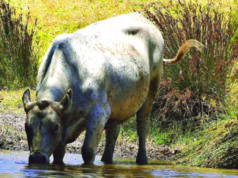
There’s been a groundswell of enthusiasm to root out the rabbits running rife around these parts.
The Peel Harvey Biosecurity Group (PHBG) is finalising preparations for the 2024 calicivirus release program which aims to assist landholders in rabbit control, with strong interest to take part coming from the local community.
Three rabbit control information sessions were held earlier this month, with the PHBG welcoming many landholders to their first PHBG event.
When asked whether attending the sessions had influenced the likelihood of undertaking pest control and why, one attendee provided feedback that they ‘feel armed with relevant information’ adding that they had received ‘information I’ve wanted for a long time, presented really well’.
Another responded: “I now understand rabbit control”.
Impacts from rabbits can be felt in large and small properties alike, with reports coming from increasingly urban locations.
Seeing rabbits ringbark newly planted and established fruit trees and vegetable gardens on domestic and commercial properties is costly and frustrating, but the impacts on the native ecosystem can be subtle and compounding.
“It would be difficult to imagine what our local area would look like today if you were able to remove the compounding impacts of rabbits through history. Rabbits graze on the same native plants that provide food and shelter to native wildlife and undermine efforts to revegetate private properties as well as local reserves” PHBG Executive Officer Teele Hooper-Worrell said.
“Recent reports suggest as little as 0.5 rabbits per hectare can stop the regeneration of certain species and exhaust the native seed bank, which seriously impacts the biodiversity of flora and fauna.
“In disturbed systems like an area overgrazed by rabbits, invasive species find it easier to thrive. Over time that system will look completely different.”
Adding a further burden to the fragile environment, an increased rabbit population provides a food source that supports higher numbers of other feral animals, like foxes.

While adult rabbits only form a small percentage of a fox’s diet, the availability of young rabbits can support inflated fox numbers. The foxes then prey on native mammals, birds and reptiles.
The calicivirus release next month will infect healthy rabbits with the RHDV1 K5 strain of this biocontrol agent. But releasing the virus alone is not enough to see a long-term reduction in numbers.
Rabbits are notorious for being prolific breeders and quickly replace themselves in number unless consistent ongoing control is undertaken.
The most important method for landholders to achieve a long-term reduction in rabbit numbers is to plan for the removal of warrens and shelters on their properties following rabbit control activities.
Researchers continue to strive to find new ways to combat feral rabbits, but for now rabbit control is achievable through diligent best-practice use of combined traditional control methods.
For properties with a heavy rabbit infestation, this could take multiple years of concerted effort.
The calicivirus release in 2024 will be funded through the Declared Pest Account, where funds collected through the Declared Pest Rate are matched by the State Government. Landholders can find more details on the PHBG website, www.PHBG.org.













